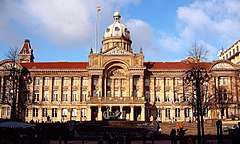List of Birmingham City councillors
| Birmingham City Council | |
|---|---|
| Third of council elected three years out of four | |

|
|
| Type | |
| Type | |
| Houses | Unicameral |
|
Term limits
|
None |
| History | |
| Founded | 1 April 1974 |
| Preceded by |
|
|
New session started
|
11 June 2013 (Municipal year 2013/2014) |
| Leadership | |
|
Leader
|
Ian Ward (acting), Labour
Since 11 September 2017 |
|
Carl Rice
Since 10 June 2016 |
|
|
Chief Executive (acting)
|
Angela Probert
|
| Structure | |
| Seats | 120 councillors |
 |
|
|
Political groups
|
|
|
Joint committees
|
West Midlands Combined Authority |
| Elections | |
| Plurality-at-large | |
|
Last election
|
|
|
Next election
|
|
| Motto | |
| Forward | |
| Meeting place | |
 |
|
| Council House, Birmingham | |
| Website | |
| www |
|
| Constitution | |
| www |
|
Birmingham City Council is the local government body responsible for the governance of the City of Birmingham in England, which has been a metropolitan district since 1974. It is the most populated local council in the United Kingdom (excluding counties) with, following a reorganisation of boundaries in June 2004, 120 Birmingham City councillors representing over one million people, in 40 wards. This means that Birmingham is technically the largest city in the United Kingdom. The council headquarters are at the Council House in the city centre. The council is responsible for running nearly all local services, with the exception of those run by joint boards. The provision of certain services has in recent years been devolved to several council constituencies, which each have a constituency committee made up of councillors from that district.
The original Charter of Incorporation, dated 31 October 1838, was received in Birmingham on 1 November, then read in the Town Hall on 5 November with elections for the first Town Council being held on 26 December. Sixteen Aldermen and 48 Councillors were elected and the Borough was divided into 13 wards. William Scholefield became the first Mayor and William Redfern was appointed as Town Clerk.
It was not until 14 January 1889 that another Charter conferred the rank of City on Birmingham. On 9 November 1891, the districts of Balsall Heath, Harborne, Saltley and Little Bromwich were absorbed into the City. The dignity of a Lord Mayor was conferred in 1896 and Sir James Smith Kt was appointed as the City's first Lord Mayor on 3 June 1896. The parish of Quinton became part of Birmingham on 9 November 1909 and two years later, under what was termed 'The Greater Birmingham Scheme', the Boroughs of Aston Manor, the Urban District of Handsworth and of Erdington, part of the Urban District of Kings Norton and Northfield and the Rural District of Yardley were all incorporated. Such was the expansion involved that the Council Chamber, originally designed to accommodate 80 members, had to be modified to seat the representatives of the new wards. Further additions occurred on 1 April 1928 (part of the Urban District of Perry Barr) and 1 April 1931 (parts of the Parishes of Solihull, Castle Bromwich, Minworth and Sheldon). By 1972, there were 39 Wards each represented by an Alderman and 3 Councillors, a total of 156 Members.
...
Wikipedia
